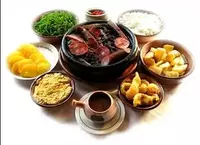The brazilian

Brazilian cuisine traditions are considered among the most perfect and harmonious among other culinary traditions in South America. Brazilian cuisine developed under the influence of three traditions: local Indian, French and Portuguese. The culinary preferences of residents of different regions of the country are very different, so it is quite difficult to draw up a single portrait of Brazilian cuisine. But it's still worth trying.
If we talk about national dishes of Brazilian cuisine, then everything is more than variegated and diverse here. For example, in the north of the country they prefer the munguzu dish - corn grains with pieces of coconut, as well as a traditional dish of green bananas fried in milk.
In the northeast, they love "carne de sol" - a dish of salted and dried meat that can be stored for a long time, as well as lobster with coconut milk. In the west, the traditional dish is "lombo de porco" - fried pork fillet and "jacare" - an alligator dish.
Meat in Brazilian recipes is usually cooked with plenty of olive oil. In general, olive oil is very popular in Brazil, most of the famous salads are seasoned with it. Brazil's climate has defined many culinary traditions. Brazilian cuisine is invariably salty and spicy. Salt helps to tolerate a hot climate, and spicy seasonings kill germs that actively develop in such a climate.
Despite the variety of dishes depending on the region of the country, one dish of Brazilian cuisine can be distinguished, which is widespread. This, of course, is a feijoad. It is made from all kinds of meat, beans, spices, special cassava flour, and served along with cabbage, orange wedges, pepper-made sauce, and sometimes rice.
Feijoada has a long history. According to legend, the recipe was invented by slaves who mixed pieces of pork left over from the master's meal and black beans that went to feed the pigs. Of course, the dish changed over time, the settlers added their ingredients, and currently feijoada is one of the most beloved dishes of Brazilian cuisine. It is difficult to imagine a feijoada without the traditional Brazilian drink - kaipirigni. Caipirinha is an unusual cocktail consisting of vodka on cane sugar, lemon and sugar.
Brazilians have a special attitude towards seafood. They love and appreciate dishes made from the gifts of the sea. Here you can distinguish "itapoa" - crab pudding, which is made from maize starch, eggs, milk and, of course, from crab or crayfish meat. "Mochuecu" is also ubiquitous - an unusual seafood broth, where dende oil and coconut milk are added for aroma.
Portuguese nuns have been responsible for desserts since time immemorial in Brazil. They also passed on their knowledge to girls from wealthy families. The recipes of Brazilian cuisine in terms of desserts are very refined and varied. Although recently, they are increasingly leaning towards simple sweets, and this is connected. Apparently, with the accelerated rhythm of modern life. Brazilians are very fond of braised or fried bananas paired with cinnamon, chocolate mousse coconuts, passion fruit mousse, and guava marmalade served with cheese.
It is difficult to overstate the significance of coffee for the people of Brazil. Coffee can be called a real symbol and hallmark of the country. A native Brazilian can drink up to 30 cups of coffee a day! The process of making coffee for Brazilians is a special ritual, where no inaccuracies and misses are allowed.
Brazilian cuisine is a very distinctive and unique cuisine. Formed from many diverse traditions, it still does not get tired of amazing with its diversity and sophistication.
 Español
Español Français
Français Português
Português Русский
Русский 简体中文
简体中文 繁體中文
繁體中文 日本語
日本語 한국어
한국어 العربية
العربية Türkçe
Türkçe Қазақ
Қазақ Deutsch
Deutsch Italiano
Italiano Українська
Українська
